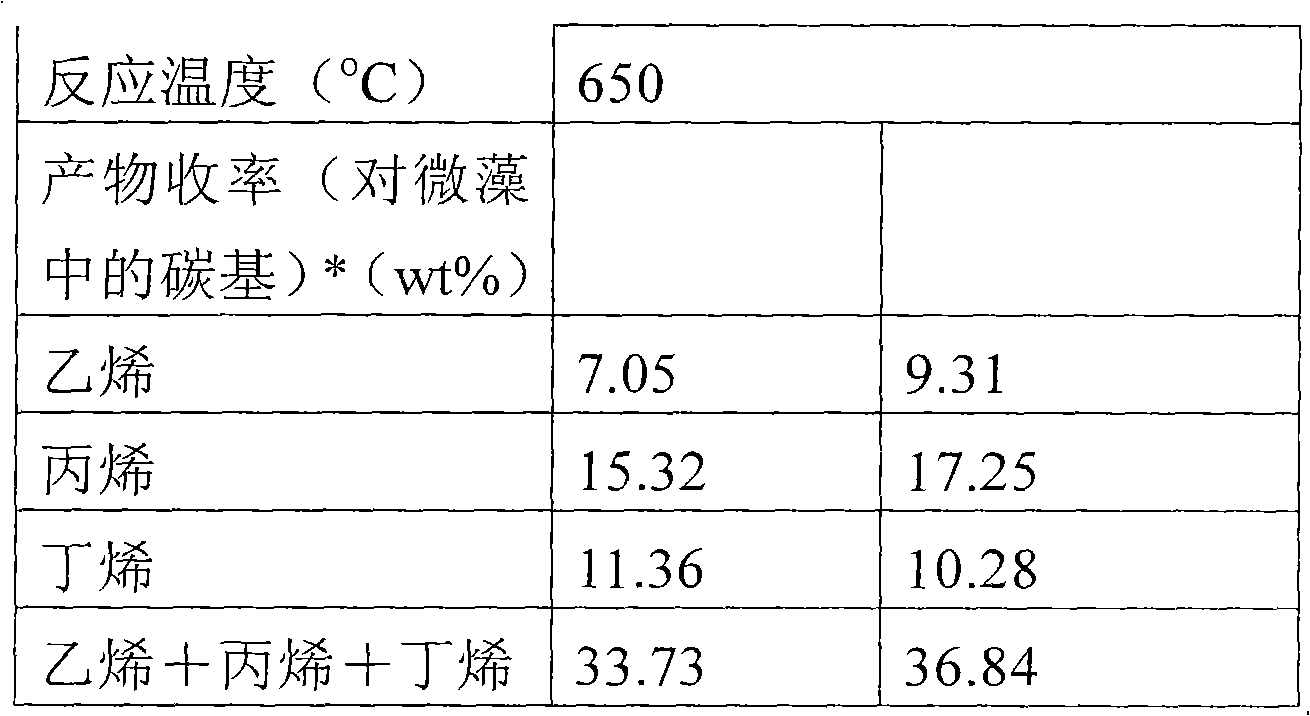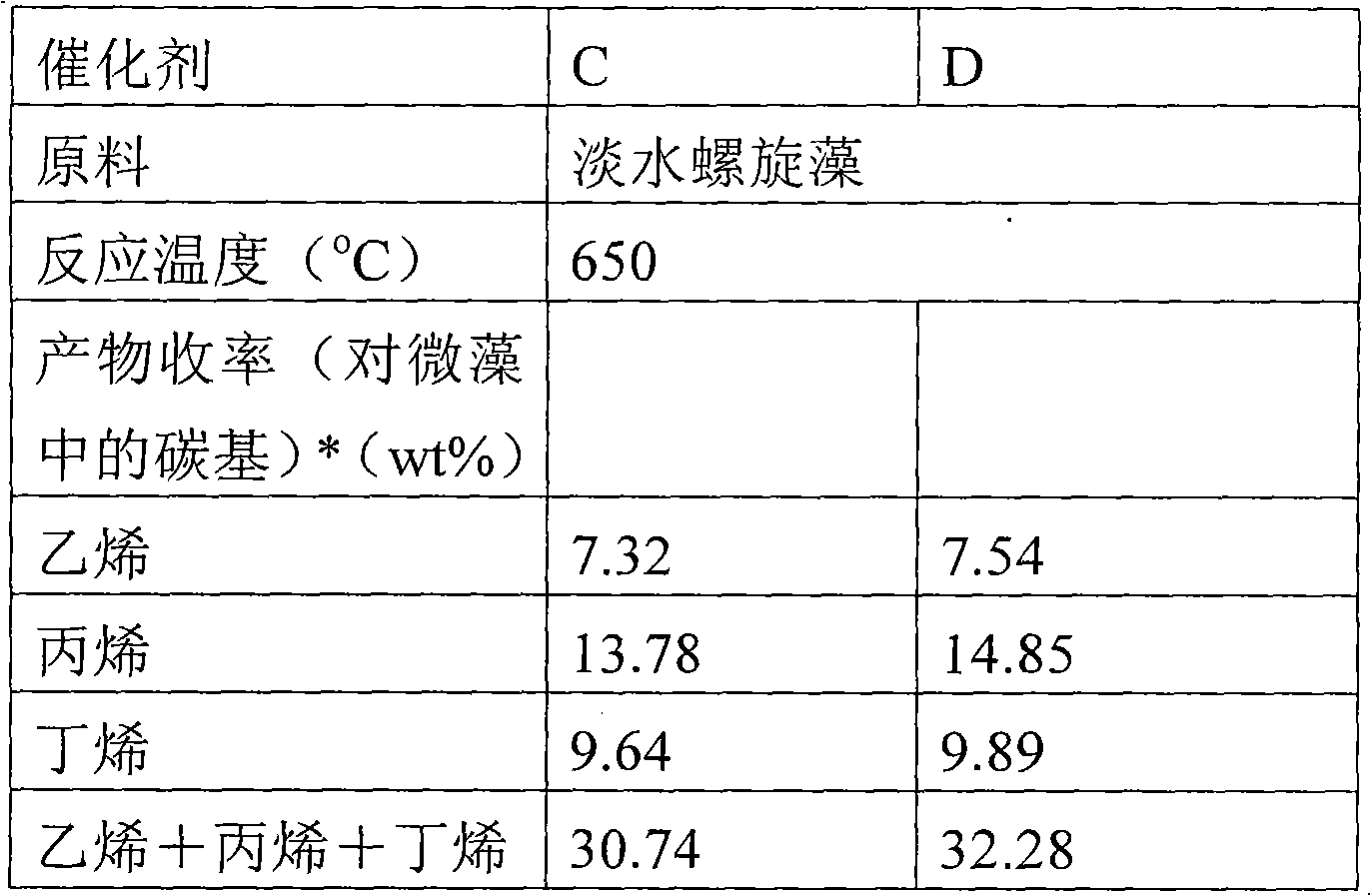Method for preparing low-carbon alkene by catalytic cracking of micro algae
A low-carbon olefins, catalytic cracking technology, applied in the fields of chemical instruments and methods, organic chemistry, hydrocarbons, etc., can solve the problem of no public reports of olefins produced by microalgae
- Summary
- Abstract
- Description
- Claims
- Application Information
AI Technical Summary
Problems solved by technology
Method used
Image
Examples
Embodiment 1
[0029] Embodiment 1: Microalgae cultivation
[0030] Seawater golden algae cultivation:
[0031] Filter natural seawater with ten layers of gauze, sterilize at 121°C for 15 minutes, cool to room temperature, add f / 2 medium to obtain seawater microalgae culture nutrient solution, the specific concentration of each component is as follows: NaNO 3 (sodium nitrate) 8.83×10 -4 M, NaH 2 PO 4 (sodium dihydrogen phosphate) 3.63×10 -5 M, Na 2 SiO 3 (sodium silicate) 1.07×10 -4 M, FeCl 3 (ferric chloride) 1×10 -5 M, EDTA.2Na (EDTA disodium salt) 1×10 -5 M, CuSO 4 (copper sulfate) 4×10 -8 M, Na 2 MoO 4 (sodium molybdate) 3×10 -8 M, ZnSO 4 (zinc sulfate) 8×10 -8 M, CoGl 2 .6H 2 O(cobalt chloride) 5×10 -8 M, MnCl 2 .4H 2 O (manganese chloride) 9×10 -7 M, B 12 1×10 -10 M, B 1 3×10 -7 M, biotin 2 x 10 -9 M.
[0032] The golden algae cells to be cultured were divided into 1.0×10 6Cells / ml were inoculated into the plate reactor equipped with the above nutrient solu...
Embodiment 2
[0033] Embodiment 2: Microalgae cultivation
[0034] Seawater diatom culture:
[0035] Filter natural seawater with ten layers of gauze, sterilize at 121°C for 15 minutes, cool to room temperature, add f / 2 medium to obtain seawater microalgae culture nutrient solution, the specific concentration of each component is as follows: NaNO 3 (sodium nitrate) 8.83×10 -4 M, NaH 2 PO 4 (sodium dihydrogen phosphate) 3.63×10 -5 M, Na 2 SiO 3 (sodium silicate) 1.07×10 -4 M, FeCl 3 (ferric chloride) 1×10 -5 M, EDTA.2Na (EDTA disodium salt) 1×10 -5 M, CuSO 4 (copper sulfate) 4×10 -8 M, Na 2 MoO 4 (sodium molybdate) 3×10 -8 M, ZnSO 4 (zinc sulfate) 8×10 -8 M, CoCl 2 .6H 2 O(cobalt chloride) 5×10 -8 M, MnCl 2 .4H 2 O (manganese chloride) 9×10 -7 M, B 12 1×10 -10 M, B 1 3×10 -7 M, biotin 2 x 10 -9 M.
[0036] The diatom cells to be cultured were divided into 1.0×10 6 Cells / ml were inoculated into the plate reactor equipped with the above nutrient solution, cultured ...
Embodiment 3
[0037] Embodiment 3: Microalgae cultivation
[0038] Freshwater Chlorella Cultivation:
[0039] Add TAP nutrient salt to triple distilled water, sterilize at 121°C for 15 minutes, and cool to room temperature to obtain freshwater microalgae culture nutrient solution. The composition of each component is as follows (mg / l): NaNO 3 100. NaH 2 PO 4 2H 2 O20, EDTA-Na45, H 3 BO 3 33.6, FeCl 3 ·6H 2 O 1.3, MnCl 2 4H 2 O0.36, ZnCl 2 0.021, CoCl 2 ·6H 2 O 0.02, CuSO 4 ·5H 2 O 0.02, (NH 4 ) 6 MO 7 o 24 4H 2 O0.009.
[0040] The green algae cells to be cultured were divided into 0.6×10 6 Cells / ml were inoculated into the plate reactor equipped with the above nutrient solution, cultured under light in the cultivation room, the temperature was controlled at 25-28°C, and fluorescent lamps with a light intensity of 3000-10000Lx were used to irradiate from both sides of the reactor. The ratio is 14h:10h. After culturing for 8 days, the green algae reaching a certain dens...
PUM
| Property | Measurement | Unit |
|---|---|---|
| Particle size | aaaaa | aaaaa |
Abstract
Description
Claims
Application Information
 Login to view more
Login to view more - R&D Engineer
- R&D Manager
- IP Professional
- Industry Leading Data Capabilities
- Powerful AI technology
- Patent DNA Extraction
Browse by: Latest US Patents, China's latest patents, Technical Efficacy Thesaurus, Application Domain, Technology Topic.
© 2024 PatSnap. All rights reserved.Legal|Privacy policy|Modern Slavery Act Transparency Statement|Sitemap



